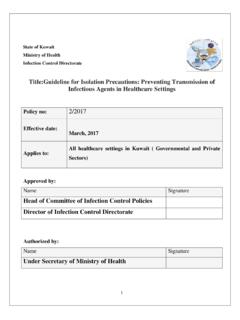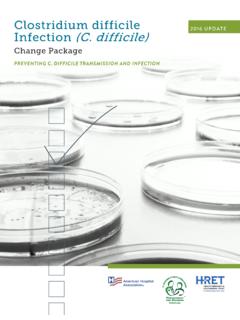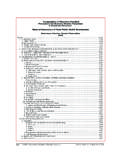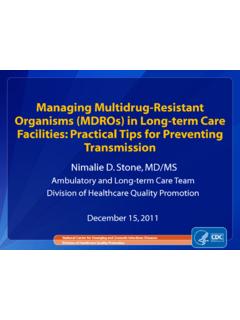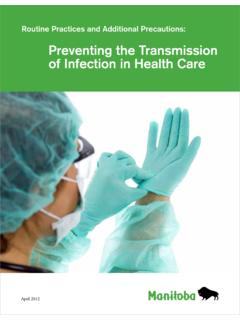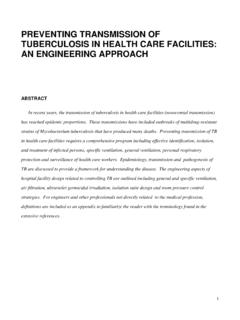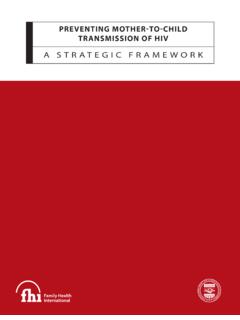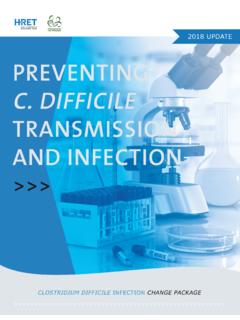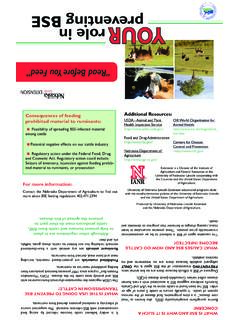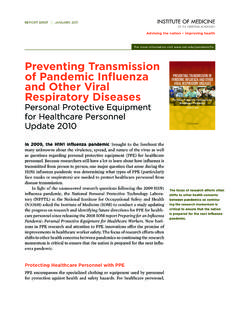Transcription of Guideline for Isolation Precautions: Preventing ...
1 Guideline for Isolation precautions : Preventing Transmission of infectious Agents in Healthcare Settings 2007 Jane D. Siegel, MD; Emily Rhinehart, RN MPH CIC; Marguerite Jackson, PhD; Linda Chiarello, RN MS; the Healthcare Infection Control Practices Advisory Committee Acknowledgement: The authors and HICPAC gratefully acknowledge Dr. Larry Strausbaugh for his many contributions and valued guidance in the preparation of this Guideline . Suggested citation: Siegel JD, Rhinehart E, Jackson M, Chiarello L, and the Healthcare Infection Control Practices Advisory Committee, 2007 Guideline for Isolation precautions : Preventing Transmission of Ifnectious Agents in Healthcare Settings.
2 June 2007 1 94 APPENDIX A1 TYPE AND DURATION OF precautions RECOMMENDED FOR SELECTED INFECTIONS AND CONDITIONS Infection/Condition precautions Type * Duration Comments Abscess Draining, major C DI No dressing or containment of drainage; until drainage stops or can be contained by dressing Draining, minor or limited S Dressing covers and contains drainage Acquired human immunodeficiency syndrome (HIV) S Post-exposure chemoprophylaxis for some blood exposures 866.
3 Actinomycosis S Not transmitted from person to person Adenovirus infection ( see agent-specific guidance under gastroenteritis, conjuctivitis, pneumonia) Amebiasis S Person to person transmission is rare. Transmission in settings for the mentally challenged and in a family group has been reported 1045. Use care when handling diapered infants and mentally challenged persons 1046.
4 Anthrax S Infected patients do not generally pose a transmission risk. Cutaneous S Transmission through non-intact skin contact with draining lesions possible, therefore use Contact precautions if large amount of uncontained drainage. Handwashing with soap and water preferable to use of waterless alcohol based antiseptics since alcohol does not have sporicidal activity 983. Pulmonary S Not transmitted from person to person Environmental: aerosolizable spore-containing powder or other substance DE Until decontamination of environment complete 203.
5 Wear respirator (N95 mask or PAPRs), protective clothing; decontaminate persons 1 Type of precautions : A, Airborne precautions ; C, Contact; D, Droplet; S, Standard; when A, C, and D are specified, also use S. Duration of precautions : CN, until off antimicrobial treatment and culture-negative; DI, duration of illness (with wound lesions, DI means until wounds stop draining); DE, until environment completely decontaminated; U, until time specified in hours (hrs) after initiation of effective therapy; Unknown: criteria for establishing eradication of pathogen has not been determined 95 APPENDIX A1 TYPE AND DURATION OF precautions RECOMMENDED FOR SELECTED INFECTIONS AND CONDITIONS Infection/Condition precautions Type * Duration Comments with powder on them ( ) Hand hygiene: Handwashing for 30-60 seconds with soap and water or 2% chlorhexidene gluconate after spore contact (alcohol handrubs inactive against spores 983.)
6 Post-exposure prophylaxis following environmental exposure: 60 days of antimicrobials (either doxycycline, ciprofloxacin, or levofloxacin) and post-exposure vaccine under IND Antibiotic-associated colitis (see Clostridium difficile) Arthropod-borne viral encephalitides (eastern, western, Venezuelan equine encephalomyelitis; St Louis, California encephalitis; West Nile Virus) and viral fevers (dengue, yellow fever, Colorado tick fever) S Not transmitted from person to person except rarely by transfusion, and for West Nile virus by organ transplant, breastmilk or transplacentally 530, 1047. Install screens in windows and doors in endemic areas Use DEET-containing mosquito repellants and clothing to cover extremities Ascariasis S Not transmitted from person to person Aspergillosis S Contact precautions and
7 Airborne precautions if massive soft tissue infection with copious drainage and repeated irrigations required 154. Avian influenza (see influenza, avian below) Babesiosis S Not transmitted from person to person except rarely by transfusion, Blastomycosis, North American, cutaneous or pulmonary S Not transmitted from person to person Botulism S Not transmitted from person to person Bronchiolitis (see respiratory infections in infants and young children) C DI Use mask according to Standard precautions . Brucellosis (undulant, Malta, Mediterranean fever) S Not transmitted from person to person except rarely via banked spermatozoa and sexual contact 1048, 1049.
8 Provid antimicrobial prophylaxis following laboratory exposure 1050. Campylobacter gastroenteritis (see gastroenteritis) Candidiasis, all forms including mucocutaneous S Cat-scratch fever (benign inoculation lymphoreticulosis) S Not transmitted from person to person Cellulitis S 96 APPENDIX A1 TYPE AND DURATION OF precautions RECOMMENDED FOR SELECTED INFECTIONS AND CONDITIONS Infection/Condition precautions Type * Duration Comments Chancroid (soft chancre) (H.)
9 Ducreyi) S Transmitted sexually from person to person Chickenpox (see varicella) Chlamydia trachomatis Conjunctivitis S Genital (lymphogranuloma venereum) S Pneumonia (infants < 3 mos. of age)) S Chlamydia pneumoniae S Outbreaks in institutionalized populations reported, rarely 1051, 1052 Cholera (see gastroenteritis) Closed-cavity infection Open drain in place; limited or minor drainage S Contact precautions if there is copious uncontained drainage No drain or closed drainage system in place S Clostridium C. botulinum S Not transmitted from person to person C.
10 Difficile (see Gastroenteritis, C. difficile) C DI C. perfringens Food poisoning S Not transmitted from person to person Gas gangrene S Transmission from person to person rare; one outbreak in a surgical setting reported 1053. Use Contact precautions if wound drainage is extensive. Coccidioidomycosis (valley fever) Draining lesions S Not transmitted from person to person except under extraordinary circumstances because the infectious arthroconidial form of Coccidioides immitis is not produced in humans 1054 . Pneumonia S Not transmitted from person to person except under extraordinary circumstances, ( , inhalation of aerosolized tissue phase endospores during necropsy, transplantation of infected lung) because the infectious arthroconidial form of Coccidioides immitis is not produced in humans 1054, 1055.
